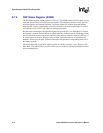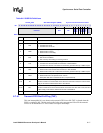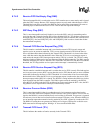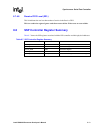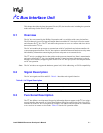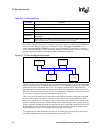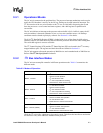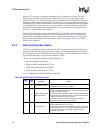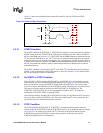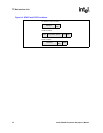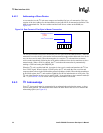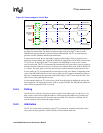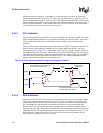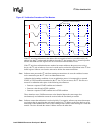
9-4 Intel® PXA255 Processor Developer’s Manual
I
2
C Bus Interface Unit
When the I
2
C unit receives an address that matches the 7-bit address found in the I
2
C Slave
Address Register (ISAR) or the general call address (see Section 9.4.8), the interface either
remains in slave-receive mode or transitions to slave-transmit mode. The Read/Write bit (R/nW)
determines which mode the interface enters. The R/nW bit is the least significant bit of the byte
containing the slave address. If the R/nW bit is low, the master that initiated the transaction intends
write data and the I
2
C unit remains in slave-receive mode. If the R/nW is high, the master that
initiated the transaction intends to read data and the I
2
C unit transitions to slave-transmit mode.
Section 9.4.7 further defines slave operation.
When the I
2
C unit initiates a read or write on the I
2
C bus, it transitions from the default slave-
receive mode to the master-transmit mode. If the transaction is a write, the I
2
C unit remains in
master-transmit mode after the address transfer is completed. If the transaction is a read, the I
2
C
unit transmits the start address, then transitions to master-receive mode. Section 9.4.6 further
defines master operation.
9.3.3 Start and Stop Bus States
The I
2
C bus specification defines a transaction START, used at the beginning of a transfer, and a
transaction STOP bus state, used at the end of a transfer. A START condition occurs if a high to
low transition takes place on the SDA line when SCL is high. A STOP condition occurs if a low to
high transition takes place on the SDA line when SCL is high.
The I
2
C unit uses the ICR[START] and ICR[STOP] bits to:
• Initiate an additional byte transfer
• Initiate a START condition on the I
2
C bus
• Enable Data Chaining (repeated START)
• Initiate a STOP condition on the I
2
C bus
Table 9-4 defines the START and STOP bits in the ICR.
Table 9-4. START and STOP Bit Definitions
STOP
bit
STAR
T bit
Condition Notes
0 0 No START or STOP
I
2
C unit sends a no START or STOP condition. Used when
multiple data bytes need to be transferred.
01
START Condition and
Repeated START
I
2
C unit sends a START condition and transmit the 8-bit IDBR’s
contents. The IDBR must contain the 7-bit address and the R/nW
bit before a START is initiated.
For a Repeated Start, the IDBR contains the target slave address
and the R/nW bit. This allows a master to make multiple transfers
to different slaves without giving up the bus.
The interface stays in master-transmit mode for writes and
transitions to master-receive mode for reads.
1 X STOP Condition
In master-transmit mode, the I
2
C unit transmits the 8-bit IDBR and
sends a STOP condition on the I
2
C bus.
In master-receive mode, the ICR[ACKNAK] must be changed to a
negative ACK (see Section 9.4.3). The I
2
C unit transmits the NAK
bit, receives the data byte in the IDBR, and sends a STOP
condition on the I
2
C bus.



